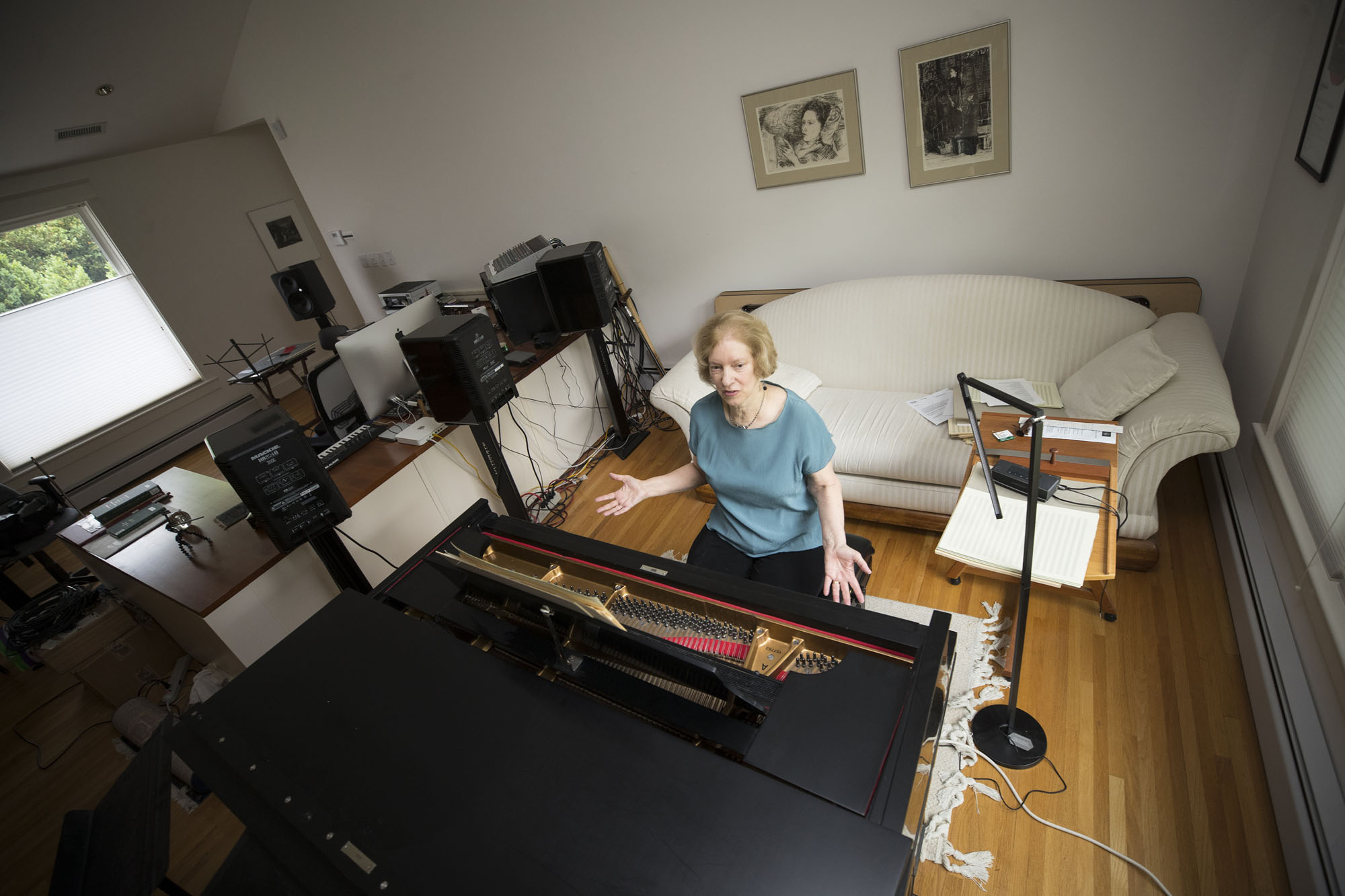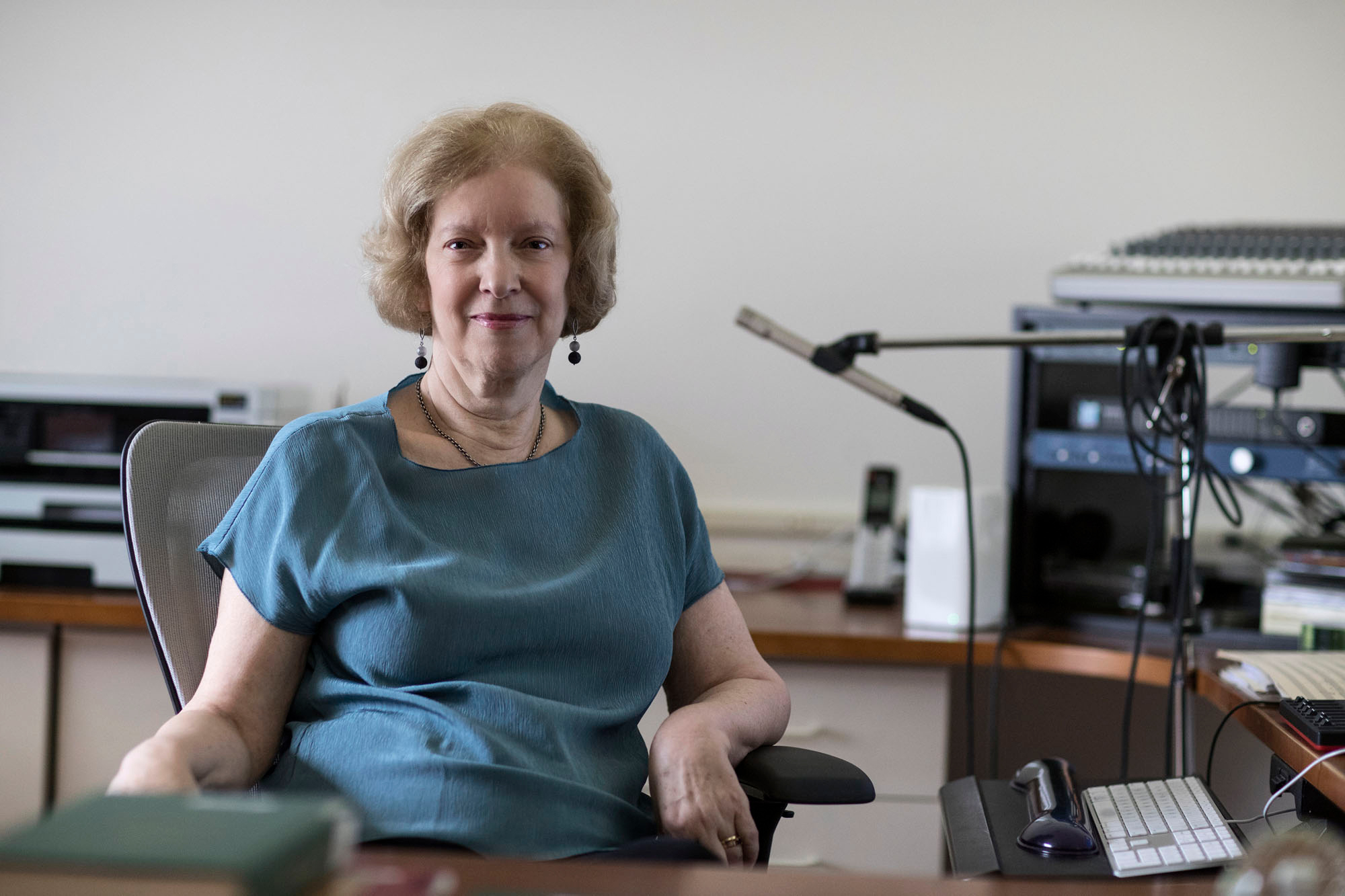Professor and composer Judith Shatin has found a succinct way to sum up the trajectory of her career.
“When I came here, we had mimeo machines. Now, we have microchips,” Shatin said, laughing. (Mimeo machines or mimeographs, in case you were wondering, were small copiers that preceded more modern photocopiers.)
Shatin, an accomplished composer who has combined acoustic and digital elements in music performed around the globe, retires this month after a 39-year career in the McIntire Department of Music at the University of Virginia. She played a seminal role in the creation of UVA’s computer music offerings, both as the founder of the Virginia Center for Computer Music and the primary architect of the department’s first Ph.D. program in composition and computer technologies.

Though she retired from the McIntire Department of Music at the end of the academic year, Shatin plans to remain involved in the department and continue her work as a composer. She is already hard at work on several commissions.
Shatin developed these programs as the technology that marks her craft changed at warp speed – from hulking mainframe computers to the ubiquitous handheld devices that captivate us today – and as the music department itself grew and transformed.
When she first started in 1979, fresh out of a doctoral program at Princeton University, the department was significantly smaller. Female professors were rare. The University had just gone fully co-educational in 1970 and there was only one other female faculty member in the music department.
“It took quite a bit longer, after UVA went co-ed, for the faculty to catch up,” Shatin said.
Being outnumbered did not stop the young composer. Hers was a male-dominated profession and there had been few women at Princeton and at The Julliard School, where Shatin studied composition. On the other hand, her undergraduate education at the all-female Douglass College (part of Rutgers University in New Jersey) afforded plenty of female classmates.
“I had been in all of those different environments,” said Shatin, who would eventually serve as president of American Women Composers Inc.
She focused on how developing technologies would allow her to continue her interest in combining acoustic and computer music. Shatin had first delved into the practice at Princeton, where she was frustrated by the limitations of the bulky mainframe computers that were available at the time.
“I wasn’t really getting results I cared about at that point,” she said. “But somehow I knew, even then, that down the road what I wanted would become possible.”
Eventually, technology started catching up to Shatin’s ambitions.
In 1987, thanks to her leadership, UVA joined Columbia, Stanford and a few other universities establishing centers for computer music at that time.
“There were not many programs at the time because computing equipment was extremely expensive,” Shatin said. “It was fairly early on in that revolution.”
Professor Scott DeVeaux, a longtime colleague of Shatin’s who joined the department in 1983, recalled watching Shatin teach herself computer music techniques and progress through all of the technology changes that followed.
“She was diligent in working her way through everything, all of the technology,” DeVeaux said. “Now it is a completely different world.’
Today, the Virginia Center for Computer Music and the composition and computer technologies doctoral program that Shatin helped found form the backbone of UVA’s robust computer music offerings.
“It has really led to a wonderful flowering, combining digital and acoustic media. We have so many people doing both, and that has been really exciting,” Shatin said. “And it has expanded our reach to all kinds of students throughout the University.”
“It really changed the nature of composition in the department,” DeVeaux said, noting that previously the music department had largely focused on acoustic music.
Associate professor and interim department chair Ted Coffey said he and others in the department are consistently impressed by Shatin’s creativity and work ethic.
“She is always doing something new, and she is always excited about what she is doing. She really models that for her students and colleagues,” he said. “She’s endlessly curious, has a tremendous work ethic and is just a really warm, elegant person.”
Shatin’s compositions continually explore the near-endless possibilities for combining computer technology and music.
“In some departments, there can be a schism between acoustic music and music technology or computer music,” Coffey said. “Judith didn’t let that happen here. She has been a leader in computer music, she writes instrumental music that’s exquisite and she can bridge these two worlds.”
You can listen to three of her compositions in this playlist.
“One of the things I find endlessly fascinating is that we can make music from sounds that just were not accessible before and transform them in ways that go beyond anything I could have imagined,” Shatin said.
Examples range from the mundane – one of Shatin’s compositions, “Tape Music,” weaves together the sounds of different tapes ripping – to the awe-inspiring – a recent piece for string orchestra and electronics, “Ice Becomes Water,” features electronics she fashioned from field recordings, such as sounds of sea ice breaking shared by glaciologist Oscar Glowacki.
She has also composed several pieces focused on UVA’s founder, Thomas Jefferson. One, “We Hold These Truths,” was commissioned by UVA to celebrate Jefferson’s 250th birthday. In it, Shatin scored a large portion of the Declaration of Independence for chorus, brass quintet and timpani music. It premiered on the Lawn following Soviet Premier Mikhail Gorbachev’s address there on April 13, 1993.
Shatin created another composition, “Jefferson in His Own Words,” for narrator and orchestra. Co-commissioned by the Charlottesville, Illinois, Richmond and Virginia symphonies, it unfolds in four movements, focusing on key aspects of Jefferson’s life, with words drawn from his letters. These include his political philosophies, personal relationships with his daughter and Maria Cosway, his contradictory beliefs about freedom and slavery and his founding of the University.
Finally, there is a film, “Rotunda,” created from more than 300,000 images and many sound recordings gleaned from a full year of observing the Lawn. UVA’s most iconic vista stretched out directly beyond Shatin’s office window, and she worked with filmmaker Robert Arnold to capture all of the activity that she saw there. A clip is shown below; the full film is available on DVD.
Excerpt from Judith Shatin's "Rotunda" from UVA Magazine on Vimeo.
“I was so inspired by looking out my window at the majesty of the Lawn and the Rotunda, and the life happening on it,” she said. “We collected over 300,000 images and I collected sound in and around the Rotunda over a year. … It was a labor of love.”
Shatin is looking forward to creating even more music in her retirement and already has several commissions to fulfill. She continually looks for new ideas, finding inspiration in literature, art, current events and even more mundane sounds, like the cacophony of a busy airport.
“I feel like I always have my antenna up,” she said.
She is also excited to have more time to attend the many concerts and classes that interest her in the music department.

“It delights me that so many of our concerts are free for students, and that we offer over 80 each year,” she said. “I have loved working not only with the University Singers, the Wind Ensemble, Percussion Ensemble and the Charlottesville Symphony, but also with student-run groups including the Glee Club and the Virginia Women’s Chorus.”
As she leaves the music department, Shatin is confident about its future.
“Our department has really expanded. I would say that it is in the best shape that it has ever been,” she said. “When I came here, there was little awareness throughout the state of what UVA had to offer in music, and that has changed.”
And the same resource that attracted her to UVA initially remains as compelling as ever: the people.
“What I liked when I first came here in 1979, and what I have liked all the way through, are the students and my colleagues, both in my department and throughout UVA,” Shatin said. “We have wonderful faculty members, great artists and outstanding students.”
Media Contact
Article Information
May 21, 2018
/content/pioneer-uvas-computer-music-program-reflects-39-year-career

